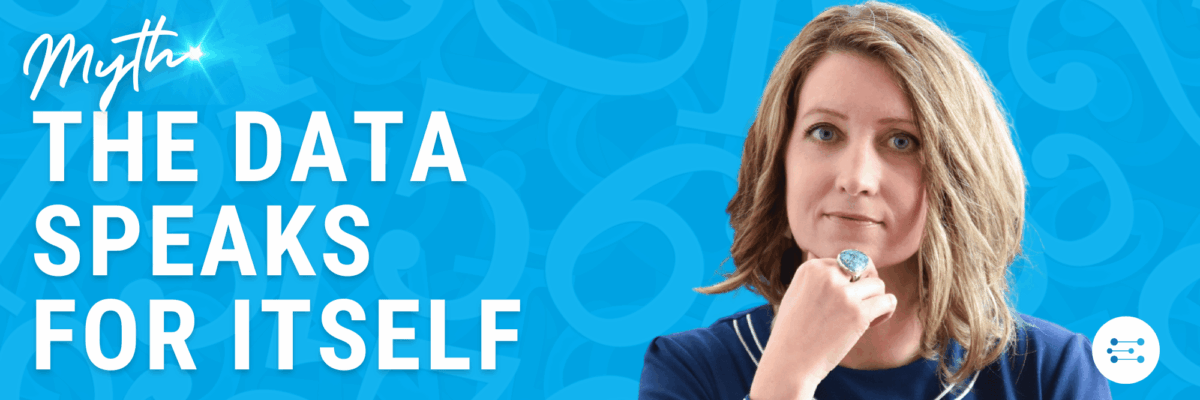Myth: The Data Speaks for Itself
Honey, I wish. We’d have a whole lot less confusion in the world if the data would just speak for itself. Systems would run more efficiently. Some roles would even be reconfigured.
This is the myth I was taught in academia. Your job as the researcher is to design a great study, analyze the data well, and then share the data with the world. Preferably in a journal article. That others will have to pay to access.
Your job is just to show the data. Don’t ya dare try drawing some conclusions – that would be premature. We’ll always need further studies and more data. (This is how academia generates more academia.)
Because, their theory goes, if you just put the data out there, others will study it and draw their own conclusions. They may even re-run your tests or analyses to see if they can produce similar results. Don’t taint the process by providing interpretations of your own data, ya amateur.
That’s why I used to visualize my data like this:

Then I’d just ship the data off to the client with my best wishes.
And this trend has continued pretty much as-is since my academic days.
Here’s an example of a visual from a report called “Kentucky Juvenile Justice Reform Evaluation. Assessing the Effects of SB 200 on Youth Dispositional Outcomes and Racial and Ethnic Disparities”
Let me explain what this graph is saying. Young offenders from Kentucky are less likely to commit future crimes and return to jail if, on their first offense, they are funneled through a diversion program, where the court hooks them up with community resources like social workers and therapists to help address broader issues in their lives.
That’s a story that has real world impacts. The ability to reduce the need for an expensive criminal justice system. A reason to channel more funding into our non-profits. Ways to improve the quality of life for our fellow citizens.
But you have to possess a pretty firm grip on data literacy and the topic at hand to look at this graph and draw those conclusions.
Yes, the researchers of this report did say something similar to this…. 20 pages later.
So, even when we are in a position where it’s ok to draw some conclusions from our data, the specific storytelling structure of a journal article is such that you present the data visually in one section of the report and then discuss your findings in another, where graphs are typically not seen.
The way we’ve been taught to tell data stories doesn’t integrate what we know about how people best learn new information.
Years ago I was giving a workshop to a couple hundred researchers at one of the US’s largest academic firms, explaining this very issue. One curmudgeon in the audience made a joke about consultants (you seem fun). He then approached me after the talk and said, “What you don’t understand about our graph is that it’s really saying….” and then my eyes glazed over so I totally missed what came next.
But it didn’t really matter.
Me: “Super cool that you can tell what your own graph says. That’s important. But what good is it if no one else can understand it? This data is about climate change. The world desperately needs to know the story your data.”
Him: “Well then the world just needs to get smarter.”
Ok good luck with that one, Buddy.
You need to meet people where they are.
The data can’t just speak for itself.
You can add storytelling tools like a clear sentence for a title…

smart color choices…

and annotations…

If you look at a default Excel line chart and compare it to the Vox chart, above, you might feel a smidge intimidated about how to get from Point A to Point B.
That’s often when folks come up with An Excuse.
Some reason not to learn new data storytelling techniques and just stick to the status quo.
Like “My audience has high data literacy and knows my topic well, so I don’t need to add any storytelling.”
Oh yeah?
Ever heard the old Buddhist parable about the blind men and the elephant?
That’s what’s happening to your tables, my friend.
Your highly data literate colleagues are pulling whatever interpretation they so choose out of your table. Your clients, intimately familiar with the topic at hand, will use the data to confirm whatever conclusion they’ve wanted all along. AKA yer data is trash.
Which means that your engagement in the research can slow down processes and contribute to inefficiency.
The data cannot speak for itself. At best, it’s telling too many conflicting stories simultaneously.
Your data needs you to gather the courage to speak for it.





